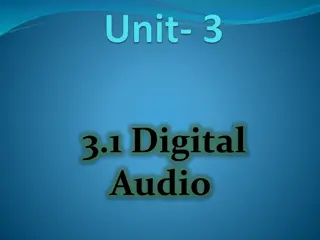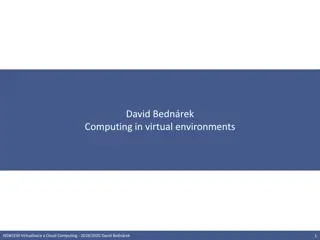Understanding Multimedia Learning Environments and Principles
Explore the world of multimedia learning through virtual environments and cognitive architecture theories. Discover the concept of multimedia, multimedia learning, and the multimedia principle. Learn why utilizing two channels for information delivery can enhance understanding, both quantitatively and qualitatively. Dive deeper into how words and pictures play different but complementary roles in multimedia learning.
- Multimedia learning
- Cognitive architecture
- Virtual environments
- Multimedia principle
- Information delivery
Download Presentation

Please find below an Image/Link to download the presentation.
The content on the website is provided AS IS for your information and personal use only. It may not be sold, licensed, or shared on other websites without obtaining consent from the author. Download presentation by click this link. If you encounter any issues during the download, it is possible that the publisher has removed the file from their server.
E N D
Presentation Transcript
Learning and Technology An Overview
Two types of Multimedia Learning Environments Virtual Learning Environments Best Explained in Terms of The Theory of Human Cognitive Architecture Windows On The World Immersive Multimedia Environments Best Explained by Social Constructivist Theory
What is multimedia? Words + Multimedia =
What is multimedia learning? Learning through the presentation of both words and pictures
The Multimedia Principle The case for multimedia learning rests on the premise that learners can better understand an explanation when it is presented via two channels (auditory/verbal & visual/pictorial).
Why might two channels be better than one? 1. Quantitative Rationale 2. Qualitative Rationale
Quantitative Rationale Quantitative Rationale: More material can be presented on two channels than on one channel
Qualitative Rationale a profound feeling of tender affection for or intense attraction to another. It is considered a deep, ineffable feeling shared in passionate or intimate interpersonal relationships. LOVE
Qualitative Rationale a seat usually having four legs for support and a rest for the back and often having rests for the arms CHAIR
Why might two channels be better than one? Qualitative Rationale words and pictures are qualitatively different (not equivalent) words are better used for abstract concepts (like self-esteem, integrity, etc.) pictures are best for more concreteimages or ideas (like chair, ball, walking, etc.)
Two views of multimedia design Design Approach Starting Point Goals Issues Technology -Centered Capabilities of multimedia technology Provide access to information How can we use technology in designing multimedia presentations? Learner- Centered How the human mind works Aid human cognition How can we adapt multimedia technology to aid human cognition
Two metaphors of multimedia design 1. Information Acquisition Memory Information
Two metaphors of multimedia design 2. Knowledge construction
Two goals of multimedia learning 1. Remembering a. Recall (essay) b. Recognition (multiple choice) 2. Understanding --ability to use presented material in novel situations
To summarize, multimedia presentations should: Be learner-centered Facilitate knowledge construction Allow for bothremembering and understanding
Richard Mayers Cognitive Theory of Multimedia Learning The Theory Graphed Assumptions Theoretical Foundations
Theoretical Foundations Paivio s DCT Schematic of Baddeley's Model Baddeley s WM Chandler and Sweller s CLT We just completed discussing this.
Richard Mayers Cognitive Theory of Multimedia Learning Theoretical Foundations The Theory Graphed Assumptions
Assumptions 1. Dual Channels Auditory/verbal Visual/pictorial 2. Limited Capacity Integrate words Organizing 3. Active Processing words &
Richard Mayers Cognitive Theory of Multimedia Learning Theoretical Foundations The Theory Graphed Assumptions
The Theory Graphed 1. Selecting words and images from the presented material involves paying attention to relevant information 3. Integrating the resulting verbal and visual represetnations with one another verbal and visual based models are constructed and then connections are built between the representations and prior knowledge in long-term memory. Multimedia Presentation Sensory Memory Long-term Memory Working Memory Selecting organizing Verbal Model Sounds Words Words words Prior Integrating Knowledge Pictorial Model Selecting organizing Images Pictures Images images 2. Organizing words and images into coherent mental representations visual and verbal information enters working memory and then needs to be organized.
How pictures are processed Multimedia Presentation Sensory Memory Long-term Memory Working Memory Selecting organizing Verbal Model Sounds Words Words words Prior Integrating Knowledge Pictorial Model Selecting organizing Images Pictures Images images
How spoken words are processed Multimedia Presentation Sensory Memory Long-term Memory Working Memory Selecting organizing Verbal Model Sounds Words Words words Prior Integrating Knowledge Pictorial Model Selecting organizing Images Pictures Images images
How printed words are processed Multimedia Presentation Sensory Memory Long-term Memory Working Memory Selecting organizing Verbal Model Sounds Words Words words Prior Integrating Knowledge Pictorial Model Selecting organizing Images Pictures Images images
Morenos Cognitive theory of learning with media (CTLM)
Morenos Cognitive theory of learning with media (CTLM) Based on the following assumptions:
Morenos Cognitive theory of learning with media (CTLM) Based on the following assumptions: 1. Learning starts when information is processed in separate channels for different sensory modalities
Morenos Cognitive theory of learning with media (CTLM) Based on the following assumptions: 2. Only a few pieces of information can be consciously processed at any one time in working memory
Morenos Cognitive theory of learning with media (CTLM) Based on the following assumptions: 3. Long-term memory consists of a vast number of organized schemas
Morenos Cognitive theory of learning with media (CTLM) Based on the following assumptions: 4. Knowledge may be represented in long- term memory in verbal and nonverbal codes
Morenos Cognitive theory of learning with media (CTLM) Based on the following assumptions: 5. After being sufficiently practiced, schemas can operate under automatic processing
Morenos Cognitive theory of learning with media (CTLM) Based on the following assumptions: 6. Conscious effort needs to be spent in selecting, organizing, and integrating the new information with existing knowledge
CTLM Instructional Technology Long-term Memory Sensory Memory Working Memory Narration Selecting Sounds Integrating Auditory Music Text Attention Connecting & Prior Visual Animation & Organizing Knowledge Graphics Perception Tactile Retrieving Manipulatives
Ten design principles derived from CTLM 1. MODALITY Students learn better from words and graphics when words are spoken rather than printed 2. VERBAL REDUNDANCY Students learn better from graphics and narration than from graphics and redundant narration and text 3. TEMPORAL CONTINGUITY Students learn better with concurrent rather than successive corresponding words and graphics 4. SPATIAL CONTIGUITY Students learn better when multiple sources of visual information are integrated rather than separated 5. COHERENCE Students learn better when extraneous material is excluded rather than included in a lesson
Ten design principles derived from CTLM 6. MULTIMEDIA Students learn better from words and graphics than from words alone 7. PERSONALIZATION Students learn better when explanations are personalized rather than nonpersonalized 8. GUIDANCE Novice students learn better when given principle-based explanations than they do when asked to infer principles by themselves 9. INTERACTIVITY Students learn better by manipulating the materials rather than by passively observing others manipulate the materials 10. REFLECTION Students learn better when given opportunities to reflect during the meaning-making process























